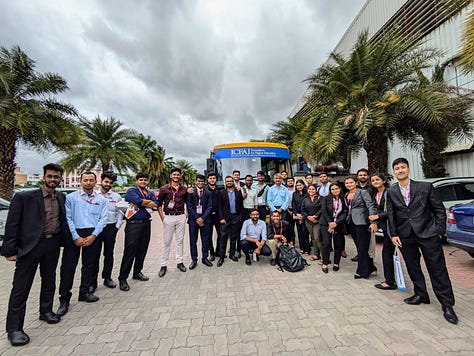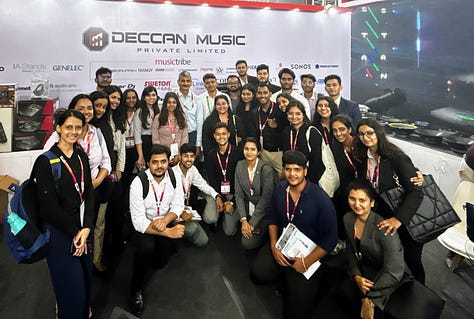हम तालिब-ए-शोहरत हैं हमें नंग से क्या काम,
बदनाम अगर होंगे तो क्या नाम न होगा।
-नवाब मुस्तफा खां शेफ्ता
Tech Platforms serve up drama, awkward moments, and wild theories, often skewing public perception and trust. Buckle up—it's a bumpy ride through today's media landscape!
BTW, how do you source your news and views? Are you subscribing to paid newsletters or media sites? I would rather go to a curated newsletter like MorningBrew or Hustle or even perhaps Twitter and then perhaps end up on another substack newsletter or even newspaper or an electronic media websites.
I am happy to note that some of you find this newsletter to be a curated repository of content on various facets of platforms so if somebody forwarded this email to you, please sign up for an awesome, dis-intermediated and fruitful relationship by clicking on following link and subscribing to the newsletter.
AND if you are a friend of the RPML, do share it with others. You can add more of your friends to the Community of Platform’ed by using the following link.
Do share your feedback on this newsletter if you have not done it yet.
DTW
During the Week, Bengaluru police commissioner issued warning to his staff to not post unrelated reels on their social media accounts while in uniform. This directive aims to maintain the department's dignity and avoid any potential controversy or misrepresentation. Officers are expected to adhere to this guideline to uphold the force's reputation. The Police Commissioner's warning can be summarized as: "Do not become news subjects" - a reminder to staff to maintain a professional image and avoid drawing unnecessary attention to themselves while representing the force on social media.
The news media cycle driven by social media trends has significantly altered the relationship between news media and tech platforms. Social media platforms like Twitter, Facebook, and Instagram have become primary sources for real-time news, pushing traditional news outlets to adapt rapidly. This shift has led to a dependency where news media rely on social media for audience engagement, reach, and instant feedback. However, this dynamic has also introduced challenges. The constant need to chase trending topics can compromise journalistic standards, as speed often takes precedence over accuracy. Moreover, the algorithms of tech platforms, designed to maximize engagement, can prioritize sensational or polarizing content, exacerbating the spread of misinformation. Tech platforms benefit from increased user activity, while news media grapple with diminished control over their narratives and revenue models. This symbiotic yet tension-filled relationship underscores the need for a balanced approach, ensuring the integrity of news while leveraging the expansive reach of social media platforms.
The dynamic relationship between digital platforms and news media has profoundly reshaped how we consume, interact with, and perceive news. This transformation can be understood through three distinct roles that platforms play: Information Gatekeepers, Engagement Catalysts, and Truth Arbitrators.
Information Gatekeepers
Platforms like Google, Facebook, and Twitter have assumed the role of Information Gatekeepers, controlling and organizing the flow of information in unprecedented ways. These platforms aggregate news and views from a plethora of sources, making information accessible to users with a simple search or scroll. This aggregation has democratized access to information, allowing users to engage with diverse viewpoints effortlessly.
For instance, news aggregator platforms such as Dailyhunt and InShorts have gained significant traction by offering multiple news sources in an easily digestible format. This model initially benefitted publishers who saw these platforms as new revenue streams amid declining traditional incomes. However, the relationship has soured as user preferences shifted towards video content on platforms like YouTube, reducing traffic and revenue for traditional news publishers. Interestingly, the rise of local language news content on these platforms has addressed the long-tail problem for migrant populations, providing news from native geographies in their native languages. Platforms aggregate news and views, sometimes fueling conspiracy theories by promoting sensational content that attracts more user engagement and clicks.
Engagement Catalysts
Digital platforms have also evolved as Engagement Catalysts, transforming how news media interacts with its audience. By leveraging the reach and interactive capabilities of platforms like YouTube, Facebook, and Twitter, news organizations have developed engaging apps and content to attract and retain users. Platforms have enabled news media to build subscription models by tapping into their vast user bases. Apple News, for example, has innovated with features like audio stories, offering narrated news content to enhance user engagement. Despite occasional confrontations over revenue-sharing and customer control, platforms like Apple have generally facilitated deeper engagement for news organizations.
However, not all is harmonious. The New York Times, for instance, withdrew from Apple News to drive readers directly to its own channels, highlighting the ongoing struggle for control over audience relationships. Platforms have pushed news media towards unbundling their offerings, leading to the rise of niche, standalone content that caters to specific interests. Talented writers Ben Thompson , Matt Levine or American history/politics expert Heather Cox Richardson have found success by focusing on specialized areas, enabled by the platform-driven subscription model. News media use platforms to engage audiences, but these channels can also spread conspiracies, undermining trust and the credibility of factual journalism.
Truth Arbitrators
Perhaps the most contentious role of platforms is that of Truth Arbitrators, where they effectively "put a thumb on the scale" in determining the veracity and visibility of information. The prevalence of fake news and misinformation has made it imperative for platforms to manage and verify content, influencing public perception and trust.
The extent of fake news has become a significant concern for law and order, prompting actions like the Press Information Bureau's (PIB) fact-checking initiatives on social media. Platforms, through their algorithms, have the power to promote or suppress content, often leading to accusations of bias and manipulation.
Aru wrote about her experience of attending an event organised by Google News Initiative, in partnership with DataLeads and InOldNews.
While you may not consider yourself a journalist, it's important to recognise that in today's digital age, we all play a role in consuming and influencing content to some extent.
Prof. Scott Galloway has described platforms like Twitter and Facebook as "rage machines," calling for stricter regulation of their algorithms, which he argues profit from propaganda and hate speech. Platforms claim they are not publishers and therefore not responsible for the content; however, evidence suggests they actively tweak algorithms to control narratives, raising ethical and regulatory questions. They often claim neutrality but their algorithms may amplify conspiracies, manipulating narratives and affecting public perception and discourse.
The interplay between news media and digital platforms continues to evolve, with platforms acting as Information Gatekeepers, Engagement Catalysts, and Truth Arbitrators. This complex relationship highlights the need for a balanced approach to regulation, ensuring platforms contribute positively to the news ecosystem while safeguarding public trust and integrity.
OTW
Over the Weekend, I accompanied my B2B Marketing students to ProWave Expo 2024, the premier event for the Professional Sound, Lighting, A/V Music Production, Installation, and Entertainment Industry. This event provided B2B Marketing students with invaluable first-hand experience, crucial for their understanding of how businesses effectively leverage exhibitions and trade fairs for promotion and networking.
Experiential learning was at the heart of B2B Trade Exhibition visit which has almost become our annual ritual during the MBA third semester. As usual, this visit allowed the students to observe and engage directly with industry professionals, offering them a fascinating opportunity to understand market trends and explore the marketing mix within the Performance Entertainment Industry. Such immersive experiences are invaluable for students as they transition from academic learning to practical application in the real world. By participating in the expo, students were able to see the theoretical concepts they’ve studied come to life. They gained insights into how businesses showcase their products, build relationships, and negotiate deals in a dynamic, real-world setting. This exposure is instrumental in preparing them for the complexities and demands of the B2B marketing landscape.



It was also a pleasure to catch up with Shrey Jain (MBA2012 ; IBS Hyderabad Official) whose company ( Deccan Music Private Limited ) was one of the anchor exhibitor at the expo.
Shrey graciously shared his insights on the industry and conducted a debriefing session for the students at the conclusion of our visit. His practical knowledge and professional experience provided a deeper understanding of the strategic importance of trade exhibitions and the networking opportunities they offer.
Let’s embrace every opportunity for hands-on experiences; they are invaluable for deepening your understanding and skills.
I Love You
Shailendra



